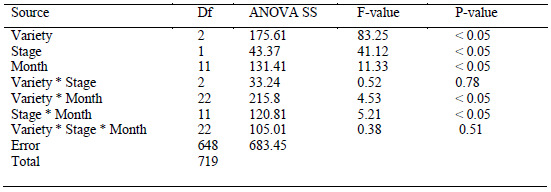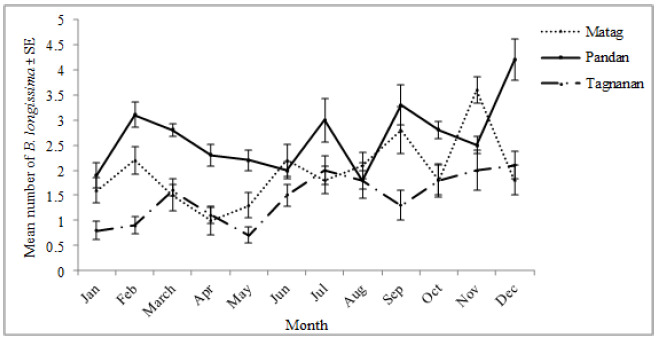JTAFS Manuscript Template
Preparation of Manuscript Please follow the example below:
Title must be in English, font type-Times New Roman, size 14 pt, bold, not more 20 words and sentence case
(Suggest a short title suitable for use as running head of not more than 50 characters - including spaces).
Author Name1*, Author Name2 and Author Name3 (corresponding author must be clearly indicated with *)
Eg: Khatijah, A.S.1*, Koh, T.Q.2 and Satyaseelan, K.M.3
1 Author Affiliation, Address, Postcode, Country
2 Author Affiliation, Address, Postcode, Country
3 Author Affiliation, Address, Postcode, Country
Abstract
Should not be more than 250 words. Papers received without an abstract will be returned to the author. It is important to give main results, new
findings (techniques, concepts, taxonomic entities, conclusions, etc.). The abstract should be complete enough for direct use by abstracting
services.
Keywords: word1, word2, word3, word4, word5, word6
Authors’ full names: Wan Khairul Anuar Wan Ali, Ahmad Azinuddin Ahmad@Ramli, Nurul Najwa Zaini, Mohd Rani Awang, Badrol
Hisham Ibrahim, and Idris Abd. Ghani.
Corresponding author: This email address is being protected from spambots. You need JavaScript enabled to view it.
©Malaysian Agricultural Research and Development Institute 2024
Introduction
Should be able to set the scene fully and clearly, include reasons and objectives why the study was conducted, as well as any previous work relating to the study, summarised by a few relevant references. The manuscript must be written in English, double-spaced throughout (text, abstract, references, tables) and single-sided on A4 paper. Font: 12 pt, Times New Roman, text should not be justified but aligned left. Length of Research Articles should not be more than 5,000 words or 25 pages (excluding tables, figures, images and references). As for Review Papers, it should not be less than 75 pages (excluding tables, figures, images and references). Main headings (Introduction, Materials and method, Results and discussion, Conclusion, Acknowledgement, References) are set in bold Roman. Minor headings are set in bold italic Roman. The recommended writing style of the manuscript is according to latest APA guidelines (www.apastyle.org).
In the text, cite the name(s) of the author(s) and years of publication by year first and then alphabetically. One author will be cited as (Rahim 2008; Ahmad 2010; Chan 2010). Two authors will be cited as (Rahim and Bakar 2008; Ahmad and Chan 2009). Three or more authors will be cited as (Rahim et al. 2008; Chan et al. 2010). Several references by one author in a particular year or different years. For an example, same year will be cited as (Rahim 2008 a, b, c).
Different years will be cited as (Rahim 2007, 2008, 2010).
Materials and method
Subheading
Should be listed clearly and succinctly, to include, where appropriate, an adequate account of layout, full description of treatments and appropriate statistical design.
Results and discussion
Subheading
Should present own results in tables, charts, figures and other appropriate means in order to provide comparative information. Discussion should thoroughly explain the results or findings from the study and interpreted with the support of evidence or data and suitable references.
Anomalous or unexpected results must be explained.
Math formulae
Math equations must be in editable text and not in images. Simple formulae in line with normal text where possible and use the solidus (/) instead of a horizontal line for small fractional terms, e.g., X/Y. In principle, variables are to be presented in italics. Powers of e are often more conveniently denoted by exp. Number consecutively any equations that have to be displayed separately from the text (if referred to explicitly in the text).
Example:


Sub subheading
The legends should be embedded in the text outline and all figures, tables and schemes should be embedded at the end of the manuscript.
Example:
Figure 1. Mean number of B. longissima beetles (± SE) infestation on three coconut palm varieties at monthly intervals
Conclusion
Should be drawn from the results and the results presented must answer the problems, issues and hypothesis put forth by the author(s).
Acknowledgement
Should list all supporting institutions and the names (preferably untitled) and the affiliations of people who have assisted and contributed to the study in some way or other.
References
Authors are solely responsible for the accuracy of the references cited. It is highly recommended that authors cite only refereed journals and books recently published.
In the reference list, the author should cite the references in the latest version of APA referencing style (www.apastyle.org). Authors’ names are listed alphabetically and then according to year sequence (earliest to the more recent) where an author has more than one reference. Arrange in alphabetical sequence of first word or title, where an author has more than one paper published in the same year, then assign letters a, b, c after the year. There is no numbering before each reference cited.
With multiple authors, the references are arranged alphabetically by first author, second author, third etc. Rahim, Chan, Pillay (2010) would appear before Rahim, Zakaria and Bakar (2008). For an author having more than one entry, the author’s name in the second and the following entry is replaced by a 3-em rule.
Examples:
Articles in periodicals (e.g. journal, bulletin)
- Chin, K.M. & Supaad, M.A. (2010). Resistance of detached organs of the rice plant to the blast. MARDI Res. Bull. 11(3): 385 – 388
- Marcus, J. (2013). Paraquat adsorption characteristics of some Malaysian soil. Pertanika 10(2): 119 – 24
- Ahmad, S., Hussein, A. & Kratzer, F.H. (2011). Effect of rancidity on the feeding value of rice bran for chickens. The Journal of Poultry Science 61: 2450 – 2455
(Refer to APA Style version 7.0)
Figures, tables and images
All figures, tables and schemes should be given clear captions/titles. In the blinded manuscript (Main Document), figures, tables and images should be arranged at the end of document. Where else, in the full manuscript (Supplemental File NOT For Review) it has to be intact in the actual positions.
Tables
Tabular materials must be kept to a minimum. Only data essential to the understanding of the text should be included in tables. All tables should be printed on separate sheets placed after the references. Tables should be numbered serially in Arabic numerals and referred to in the text.
Title should be written at the top of the table. Abbreviations in the table should be adequately explained in the footnotes. Units of measurement should be placed in column heads. Vertical rules should not be used. Horizontal rules should be inserted only above and below column headings and at the foot of the table.
Table 1. Results of 3-WAY ANOVA on the number of larvae and adults of B. longissima on coconut trees at a plot in Hilir Perak, Perak

Figures and images
Figures should only be used where they are essential to elucidate the text. They should be numbered consecutively in Arabic numerals and each must be referred to in the text. Title should be in italics and placed at the bottom of the figures. Drawings should be done in black ink. Clear patterns away from areas of type, and avoid mixing type faces on the same figures, grid marks should point outwards, legends to horizontal axis should run from left to right while for vertical axis legends should run from bottom to top. Use the same symbols (e.g. ● ○ ■ □ ▲◊ ♦ etc) for all the graphs in one paper. The style of the figures within any one paper should be as closely matched as possible. Suitable electronic formats for figure(s) and image(s) are .jpg and .gif files at a minimum resolution of 300 d.p.i. It is highly recommended for authors’ to include interesting images of the research work in the manuscript. Selected image will be used in the cover page of the upcoming issue of JTAFS.

Figure 1. Mean number of B. longissima beetles (± SE) infestation on three coconut palm varieties at monthly intervals
(Revised: January 2024)


